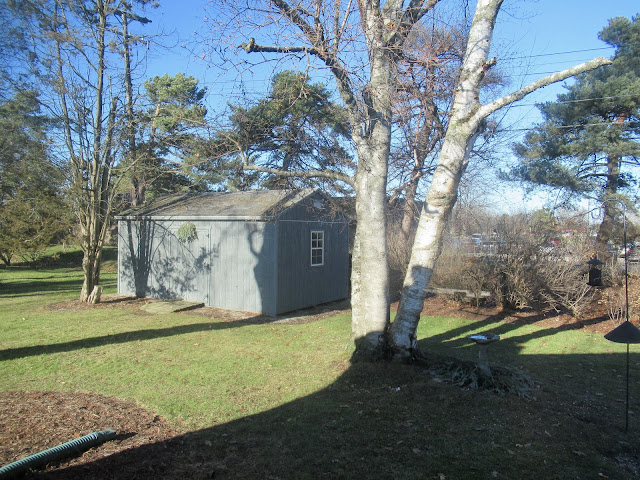Buddy, C and I hope all had a pleasant holiday!
On Christmas night, there was a bun couple out in the Back 40. Hopefully, there was some corn and sunflower seeds left for them on the buffet.
Later, around 2am, C was up and saw a doe at the Diner.
12/26-it was warming up and the snow was going fast.
A nutkin was the main visitor to the Diner. I think it is a female.
Our friend Chana came over for supper celebrating her birthday and Hanukkah which began this year on 12/25. I made cottage pie and challah, a traditional Jewish braided bread.
12/28-already in the 40's as the sun rose. The snow is gone.
Mid-morning the turkeys were out and about. I have picked up on a pattern of theirs as they are making their rounds of neighborhood Diners: while they were leaving Benny's on their way across the street, they sent a scout over to our Diner to see if there are any goodies left-like corn.
Alas, no corn so they moved on.
In the afternoon, the sun peeked out frequently. The temps were pushing the middle 50's and it felt like mid-March.
12/29-it was raining in the morning.
Buddy was snoozing on the couch.
12/30-beautiful sunny day with temps in the high 40's-again, it felt like mid-March. In the afternoon, I could hear someone in the neighborhood mowing over their leaves.
12/31-old man Winter returns. He's been particularly bi-polar this season even by Michigan standards. Sheesh.
꩜
We were watching "Lifeboat", a 1944 film directed by Hitchcock based on a novella by John Steinbeck concerning survivors of a U-boat attack in a lifeboat. The phrase "good lord Harry" was used which neither C or I had heard before. From what I can glean, "Harry" is a euphemism for Satan. The origins are sketchy but seem to point to one of England's monarchs and here, Harry is often used in lieu of Henry particularly Henry IV or Henry VIII.
꩜
The US Fish and Wildlife Service recently purposed that the Monarch butterfly be placed on the endangered species list.
꩜
You pass the anniversary of your death every year.
 |
| I'll be seeing you, one of these days. |
꩜
I'm often terrified when driving on campus because of this!
꩜
The mysterious Ksar of Draa in Timimoun-Located in central Algeria, a Ksar is a fortified village consisting of granaries and houses. Little had been recorded about this place although a Jewish symbol is found on one of the walls. One thought is that it was built 12th-14 Century by Jewish merchants as a Caravanserai were roadside inns providing lodging, food and water for travelers. They were also centers for the exchange of goods and culture.
Abuna Yemata Guh-located in Tigray, Northern Ethiopia, it is one of the most inaccessible places of worship in the world. Perched 650 feet above a cliff and created in the 5th Century, the interior is adorned with frescos.
Uyuni salt flats, Bolivia:
Nordic wild ice skating:
꩜
Midlake, a curious alt folk rock band from Texas founded in 1999. Here's a cut "Roscoe" from the 2006 album "The Trials of Van Occupanther" with a wonderfully surreal cover:
The inimitable Tom Waits: "Jockey Full of Bourbon" featured on Jim Jarmusch 1986 film "Down By Law":
Edna Million in a drop dead suit
Dutch Pink on a downtown train
Two-dollar pistol but the gun won't shoot
I'm in the corner on the pouring rain
Sixteen men on a dead man's chest
And I've been drinking from a broken cup
Two pairs of pants and a mohair vest
I'm full of bourbon, I can't stand up
Your house is on fire, your children alone
Hey little bird, fly away home
Your house is on fire, your children alone
And I've been stepping on the devil's tail
Across the stripes of a full moon's head
through the bars of a Cuban jail
Bloody fingers on a purple knife
Flamingo drinking from a cocktail glass
I'm on the lawn with someone else's wife
Admire the view from the top of the mast
House is on fire, your children alone
Hey little bird, fly away home
House is on fire, your children alone
Your house is on fire, your children alone
Hey little bird, fly away home
House is on fire, your children alone
Stazybo horn and a Slingerland ride
"To the carnival" is what she said
A hundred dollars makes it dark inside
Edna Million in a drop dead suit
Dutch Pink on a downtown train
Two-dollar pistol but the gun won't shoot
I'm in the corner on the pouring rain
Your house is on fire, your children alone
Hey little bird, fly away home
Your house is on fire, your children alone
Danny Elfman, the prolific composer for film and TV, notably creating The Simpsons theme, began with a music theater group called The Mystic Knights of Oingo Boingo in the early 70's. In 1979, he reformed the group into Oingo Boingo, a new wave band. In 1976, The Mystic Knights appeared on the Gong Show talent contest and won. The Gong Show was strange for the time with host Chuck Barris. Here is that segment just as gonzo as its host: whoa!
I stumbled across this original gem: The Pink Floyds performing a 1950s jazz version of "Wish You Were Here":
It's an interesting concept especially when you consider the Pink Floyd name came from an amalgam of Pink Anderson and Floyd Council-both Piedmont style bluesmen whose albums were in Syd Barrett's collection.













































